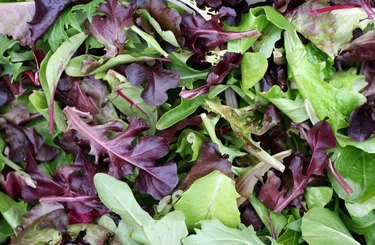
What is commonly known as lettuce rust is technically known as "russet spotting." Russet spotting on lettuce is safe to eat, but it does make the food unattractive.
Russet spotting occurs because of a chemical reaction that involves ethylene gas, and it can be minimized with certain handling and storage practices. Bruised or damaged produce is also more susceptible to russet spotting.
Video of the Day
Video of the Day
Tip
While your lettuce might look "rusty," these russet spots are caused by exposure to ethylene gas. It might not look appetizing, but russet spotting on lettuce is safe to eat. Minimize this unsightly side effect by handling and storing lettuce appropriately.
Brown Spots on Lettuce
Ethylene gas is thought to regulate growth in plants and coordinate their ripening. Tractors, trucks and other machinery that have internal combustion engines also give off ethylene gas and can cause plants to ripen faster and develop rust spots.
Fruits such as apples, bananas, peaches and tomatoes give off the highest levels of ethylene and greatly affect vegetables such as lettuce, which exude low levels of ethylene. Store your lettuce away from your fruits to reduce ethylene exposure.
Ethylene gas causes greens to yellow faster and causes brown spots on lettuce. It also causes carrots to become bitter and potatoes to sprout faster.
Minimizing Gas Exposure
Lettuce harvesters can reduce rust on lettuce by vacuum-cooling their harvest and storing it just above freezing temperature. Cold temperatures reduce respiration rates in lettuce and slow the ethylene reaction.
Well-ventilated coolers can help minimize ethylene exposure. Avoid storing your lettuce along with fruits, as recommended by the University of California. Potassium permanganate products can be used to absorb excess ethylene gas, as explained in a November 2016 article published by Nutrition and Food Science.
Lettuce should be stored in a bag, in the crisper drawer of your refrigerator to keep the moisture level high. According to the University of Georgia Extension, lettuce can be stored for up to one week and maintain freshness.
It isn't simply the presence of ethylene gas that causes rust on lettuce; it is damage to the lettuce itself. This may occur during harvest, handling and transport. Bruised or otherwise damaged lettuce is more susceptible to the chemical reactions that occur with ethylene gas, according to PennState Extension.
Understand Why It Occurs
Russet spotting occurs as plant compounds known as polyphenols react with enzymes present in the lettuce, according to the University of California. Normally, the polyphenols and enzymes don't come into contact with each other, but damage due to aging, handling and ethylene exposure allows the compounds to mix.
The oxidizing effect allows polyphenols to link together and produce the red spots on Romaine lettuce and brown pigment we know as lettuce rust. No one is truly sure about why russet spotting occurs.
The commonly-held belief is that this reddish-brown pigment and russet spotting on Romaine lettuce offers some defense against plant attackers such as fungi and insects, the historical causes of plant damage.
- University of California: "Lettuce, Crisphead"
- University of Georgia Extension: "Home Garden Lettuce"
- PennState Extension: "Keeping Produce Fresh: Best Practices for Producers"
- Nutrition and Food Science: "Role of Potassium Permanganate Ethylene on Physicochemical Properties, During Storage of Five Different Tomato Cultivars"